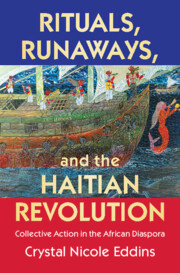Book contents
- Rituals, Runaways, and the Haitian Revolution
- Cambridge Studies on the African Diaspora
- Rituals, Runaways, and the Haitian Revolution
- Copyright page
- Dedication
- Contents
- Figures
- Tables
- Acknowledgements
- Introduction
- I Homelands, Diaspora, and Slave Society
- II Consciousness and Interaction: Cultural Expressions, Networks and Ties, Geographies and Space
- 3 “God knows what I do”: Ritual Free Spaces
- 4 Mobilizing Marronnage: Race, Collective Identity, and Solidarity
- 5 Marronnage as Reclamation
- 6 Geographies of Subversion: Maroons, Borders, and Empire
- III Collective Action and Revolution
- Conclusion
- Notes
- References
- Index
4 - Mobilizing Marronnage: Race, Collective Identity, and Solidarity
from II - Consciousness and Interaction: Cultural Expressions, Networks and Ties, Geographies and Space
- Rituals, Runaways, and the Haitian Revolution
- Cambridge Studies on the African Diaspora
- Rituals, Runaways, and the Haitian Revolution
- Copyright page
- Dedication
- Contents
- Figures
- Tables
- Acknowledgements
- Introduction
- I Homelands, Diaspora, and Slave Society
- II Consciousness and Interaction: Cultural Expressions, Networks and Ties, Geographies and Space
- 3 “God knows what I do”: Ritual Free Spaces
- 4 Mobilizing Marronnage: Race, Collective Identity, and Solidarity
- 5 Marronnage as Reclamation
- 6 Geographies of Subversion: Maroons, Borders, and Empire
- III Collective Action and Revolution
- Conclusion
- Notes
- References
- Index
Summary
This chapter uses analysis of over 10,000 runaway slave advertisements in an in-depth look at marronnage through the lens of network building, identity formation, and race and solidarity work. Nearly half of the thousands of runaways described in the Les Affiches américaines advertisements fled within a small group of two or more people. Many were racially or ethnically homogeneous maroon groups that rallied around their collective identity, while groups composed of diverse ethnic backgrounds bridged their differences to forge an emerging racial solidarity. The chapter also explores the complex relationships between enslaved people, maroons and free people of color since absconders often had previous relationships with and sought refuge with people beyond their immediate plantation, highlighting the importance of social capital in finding success at marronnage.
- Type
- Chapter
- Information
- Rituals, Runaways, and the Haitian RevolutionCollective Action in the African Diaspora, pp. 147 - 182Publisher: Cambridge University PressPrint publication year: 2021

